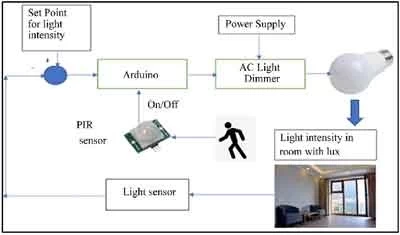Wireless Mesh Networks in Scalable Lighting Control

Wireless mesh networks represent a significant evolution in communication technology, offering a robust, flexible, and scalable solution for building automation, especially in lighting control systems. Unlike traditional star topology networks, mesh networks consist of nodes that directly communicate with each other, creating a dynamic and interconnected system.
Building Automation Systems (BAS) offer a powerful tool for managing and optimizing lighting systems within modern buildings. Traditionally, BAS relied on wired connections between lighting fixtures and control units. However, the emergence of wireless mesh networks (WMNs) is transforming the landscape of BAS-controlled lighting, offering significant advantages for scalability, flexibility, and cost-effectiveness.
Visit Our Building Automation Study Course
The Advantages of Mesh Networks for Lighting Control
Reliability and Self-Healing
One of the primary benefits of wireless mesh networks is their inherent reliability. In a mesh network, each node is connected to multiple other nodes, allowing for multiple pathways for data transmission. This redundancy means that if one node fails or a path is obstructed, the network can automatically 'self-heal' by rerouting data through alternative pathways, ensuring continuous operation.
Flexibility and Scalability
Mesh networks offer exceptional flexibility and scalability. They can easily accommodate additional nodes, making them ideal for lighting control systems that need to expand or adapt to changing building layouts. This flexibility allows facility managers to add or remove lighting fixtures or sensors without overhauling the entire network infrastructure.
Improved Network Coverage
The distributed nature of mesh networks ensures better coverage and network stability, even in areas where traditional Wi-Fi signals may be weak. This is particularly beneficial in large or complex building environments, where lighting control systems must operate reliably across diverse spaces.
Driving New Possibilities in Automated Lighting
Advanced Control and Integration
Wireless mesh networks facilitate advanced lighting control schemes, including dynamic adjustments based on occupancy, ambient light levels, and even energy consumption patterns. They can integrate seamlessly with other building management systems (BMS), allowing for a more cohesive and intelligent automation ecosystem.
Energy Efficiency and Cost Savings
By enabling more precise control and responsive lighting systems, mesh networks contribute to significant energy savings. They reduce the need for unnecessary lighting, lower operational costs, and contribute to a building’s overall energy efficiency goals.
Enhanced User Experience
With the aid of wireless mesh networks, lighting systems can offer enhanced user experiences. Occupants can personalize lighting settings via smart devices, improving comfort and satisfaction. The network's adaptability also ensures that lighting conditions can be optimized for different activities and times of the day, enhancing the functionality of the space.
The Advantages of Wireless Mesh Networks
WMNs offer several advantages over traditional wired connections in BAS-controlled lighting systems:
- Scalability: WMNs are inherently scalable. Adding new lighting fixtures or sensors to the network is a relatively simple process compared to running additional wires. This is particularly beneficial for large buildings or spaces with frequently changing layouts.
- Flexibility: WMNs eliminate the need for pre-installed cabling, offering greater flexibility during building construction or renovations. They also allow for easier reconfiguration of lighting zones or control strategies within the BAS.
- Reduced Installation Costs: Eliminating the need for extensive cabling significantly reduces installation costs compared to wired systems. This can be a major advantage for new construction projects or retrofitting existing buildings.
- Reliability: WMNs are inherently robust. Each node in the network acts as a router, relaying information and ensuring data redundancy. This minimizes the impact of a single device failure on the overall network performance.
- Ease of Maintenance: Troubleshooting and maintaining a wireless network can be simpler compared to wired systems. Additionally, adding or removing devices requires minimal disruption to the existing infrastructure.
WMNs in Action: New Possibilities for Lighting Control
WMNs are unlocking innovative possibilities for lighting control within BAS:
- Granular Control: WMNs enable granular control over individual luminaires or groups of lights. Occupancy sensors or other devices can provide real-time data on space utilization, allowing BAS to adjust lighting levels in specific zones for improved energy efficiency and occupant comfort.
- Integration with IoT Devices: WMNs can seamlessly integrate with other Internet of Things (IoT) devices within a building. For instance, integrating with HVAC systems allows for coordinated control of lighting and temperature, further optimizing building energy consumption.
- Remote Management and Monitoring: Building managers can remotely access and monitor the BAS lighting system through a web interface or mobile app. This allows for real-time adjustments, troubleshooting from a central location, and data-driven optimization of lighting settings.
- Enhanced Security: Modern WMNs offer robust security features to protect against unauthorized access or data breaches within the lighting control system.
Technical Considerations in Implementing Mesh Networks
Network Security
While wireless mesh networks offer many advantages, they also pose security challenges. Ensuring the security of the network against unauthorized access and cyber threats is paramount. Employing robust encryption and authentication measures is essential to protect the network and its data.
System Compatibility and Interoperability
For a seamless operation, the components of the mesh network, including lighting controllers, sensors, and management software, must be compatible. Interoperability standards like Zigbee, Bluetooth Low Energy (BLE), and Wi-Fi are crucial in ensuring that devices from different manufacturers can work together effectively.
Installation and Maintenance
While mesh networks reduce the need for extensive wiring, their installation and maintenance require technical expertise. Proper planning and deployment are crucial to optimize network performance and ensure reliability.
Wireless mesh networks are transforming the landscape of building automation, particularly in lighting control systems. Their ability to offer reliable, flexible, and scalable solutions opens up new possibilities for advanced, energy-efficient, and user-centric lighting schemes. Despite the technical challenges, with careful planning and implementation, mesh networks can significantly enhance the operational efficiency and comfort of automated lighting systems, marking a significant step forward in smart building technologies.





